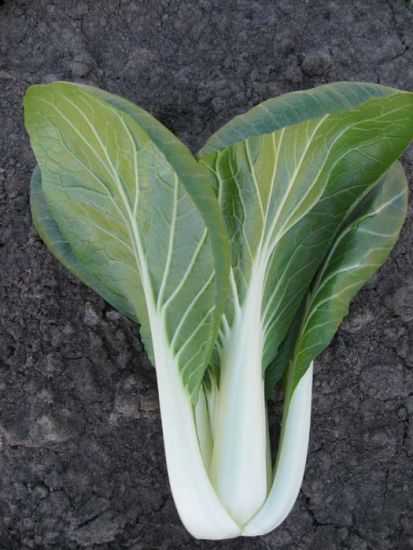Bopak (Pak Choi/hybrid/untreated)
Latin Name: Brassica rapa var. chinensis
Item #: 1250234U
Maturity:
40 Days
Difficulty:
Easy
MUSTARD CABBAGE Bok or Pak Choi (Heavy & Fine)
Approx. 7,200 plants per acre/.4047 ha; 3,000 plants per oz./28 g Brassica chinensis. Sometimes referred to as Pai Tsai or white cabbage by oriental farmers. This is perhaps the most familiar of all the chinese greens - both the deep green leaves and white chunks of stem are a staple of Oriental restaurants. Bok Choy looks quite similar to white swiss chard. There are three basic varieties used
(a) Heavy-wide celery or chard-like white stalks at the outside of the plant, with tender, slimmer stalks at the center of the plant. This strain is fairly hardy and can be raised quite successfully in most parts of Canada and the U.S.A. (except Alaska or other long day length places) with about the same bolting problems as cauliflower or carrots. In other words, if the weather is terrible (too hot in the day and almost freezing at night - or very dry, followed by torrents of rain) it will bolt to seed.
(b) Fine white Chinese strain from the mainland this has a higher percentage of very fine celery-like stalks and is one of the staples of Cantonese dishes. Because it is almost tropical in nature, it will bolt to seed quite easily during North America's spring or early fall weather. Both the white and green fine strains should only be direct seeded in late July for Sept. harvests. Earlier sowing or transplanting will bolt to seed.
(c) Fine green Chinese strain developed in Taiwan as an alternate source to the fine white strain, which sometimes is very hard to obtain. All three strains have very tender stalks and heart just like celery, but without the stringiness.
CULTURE: Sow heavy strains in late April and fine strains in late July. Do not transplant. Seeds should be sown thinly, 0.25 in/6 mm deep at 6 seeds per ft/31 cm Space rows 18 in./46 cm apart. Seeds germinate in 7 to 10 days. When seedlings are about 3 in/8 cm tall, thin to 6 in/15 cm. apart. These thinnings should not be thrown away, they make a great addition to spring or fall wok cooking. Fertilize frequently with light applications of 4-10-10.
HARVEST: should begin about 50 days from seeding when the plants are 10-14 in/25-35 cm high. The outside stalks are harvested repeatedly just like leaf lettuce. The center stalk can be cut off or topped like broccoli to force more side shoots. Remember, long daylight periods will cause Bok Choy to flower immediately so growing periods should be scheduled so that the main growth period occurs in early June or August. Bok Choy will tolerate just about any type of soil providing sufficient basic fertilizers are used. It does require ample moisture and all three types will bolt during very dry hot weather.
COOKING: The blanched inner heart or tender young inner stems are considered a delicacy. Outer stems are the most popular ingredient of Chow Mein and Chop Suey. Fresh Bok Choy will keep for about 5 days if chilled.

